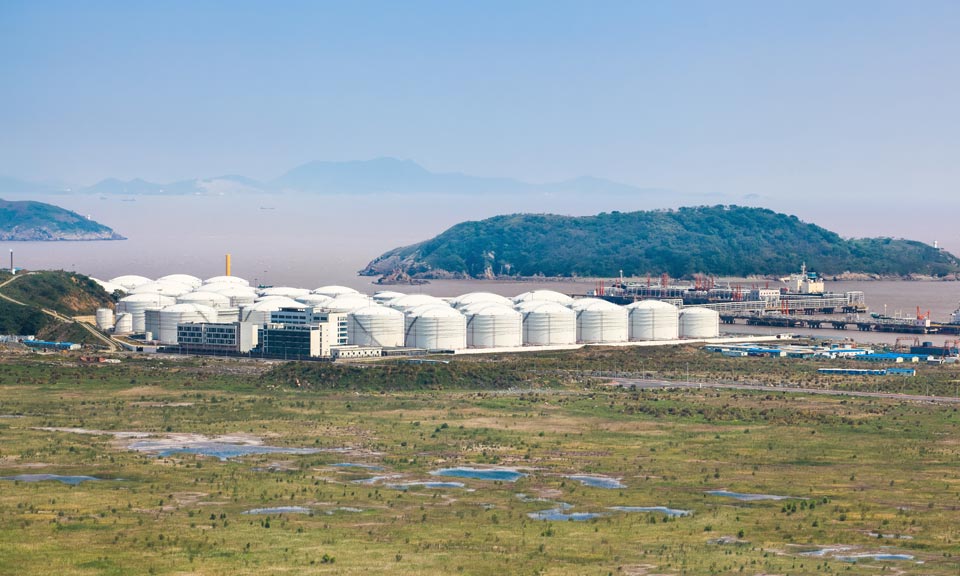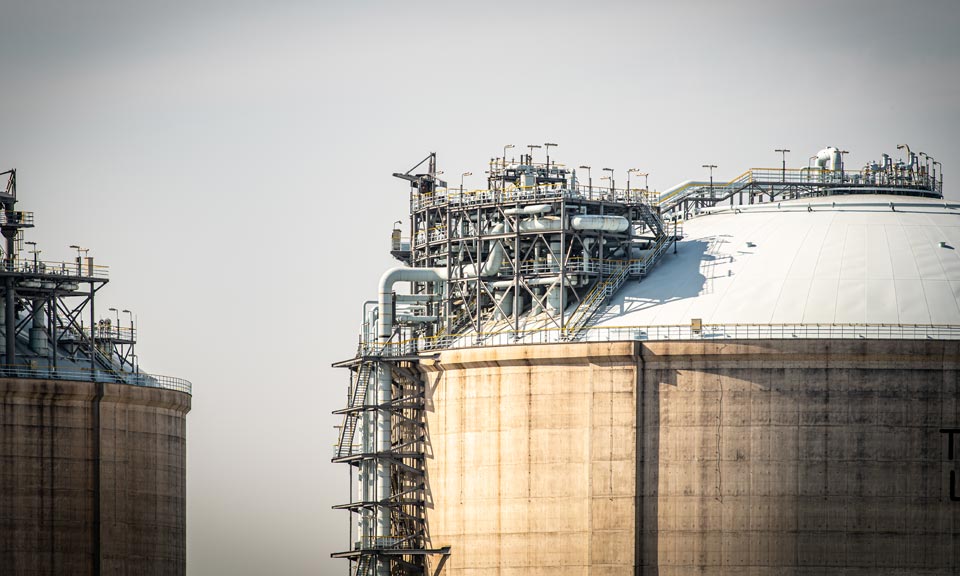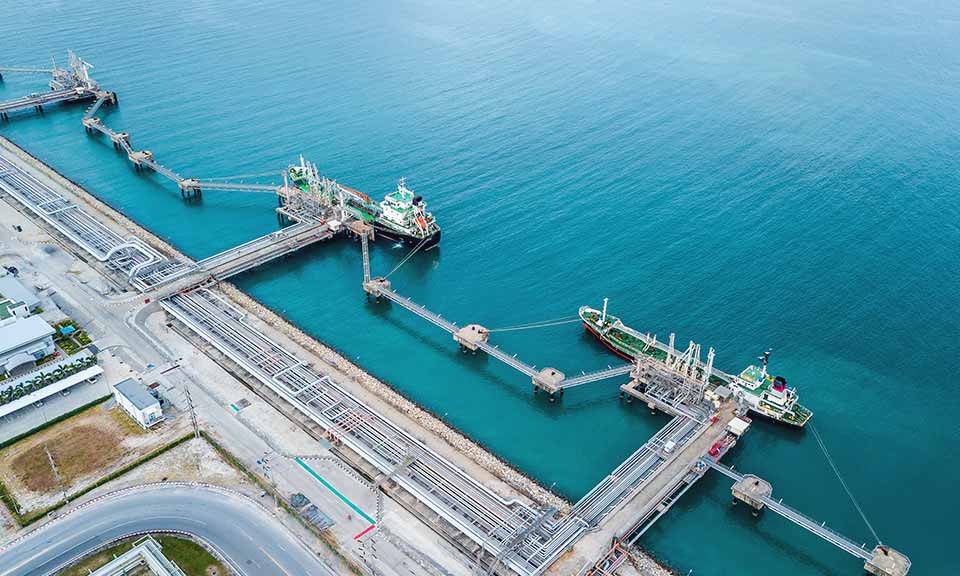Forging links: The difficulties facing trucked LNG pricing in China

China's LNG and natural gas markets are unique. Unlike in other North Asian countries, only one-fifth of China's natural gas consumption is for power generation. Its collective industrial consumption (including fertilizers) accounts for 50% of total gas consumption*.
| China's natural gas demand by sector | |||
| Sector | 2022* (Bcm) | 2021 (Bcm) | % Growth |
| Power generation | 73.3 | 66 | 11.1% |
| Industrial sector | 159.9 | 145.2 | 10.1% |
| City gas | 124.4 | 116.4 | 6.9% |
| Fertilizer and chemicals | 37.9 | 37.9 | 0.0% |
| Total | 395.4 | 365.4 | 8.2% |
| Note: * Calculation volume based on the growth rates provided by CNPC ETRI | |||
| Source: CNPC Economics & Technology Research Institute | |||
China's trucked LNG is a much-followed part of this unique market. There are a few reasons for this: LNG that leaves import terminals by truck – totalling around 22 million mt in 2021 – accounts for around 30% of China's LNG import volume, which was the largest in the world in 2021. It is also a very prompt market and not price-regulated. Therefore, it can give an indication of the immediate prevailing fundamentals in the region of China the trade takes place.
In this sense, China's trucked LNG market is similar to the port stocks trade that takes place for other major bulk commodities, such as iron ore or coal. Like these commodities, the trade takes place off the back of imported cargoes, and it happens in many locations around China – each with different local market dynamics – making it hard to have a unifying "trucked LNG price". For instance, in south China, there's less connectivity to pipeline gas from than the north and east China, so it is relatively more reliant on LNG and therefore the demand for trucked LNG comes from power generation, industrial and city gas. In northern China, trucked LNG demand comes mainly from the industrial sector. The regional imbalances can be so big that they can attract, occasionally, trucked LNG from one part of the country to another, as what happened in April 2022, when there were sales of trucked LNG from north to south China.
Cargo benchmarks solve this issue by reflecting a whole seaboard or multiple locations, meaning that the fundamentals of the whole are reflected, rather than the minutiae of the local.
Unlike these other commodities, in some ways trucked LNG trade is taking place due to a lack of infrastructure: pipelines. Nearly always it would be more cost-effective in the long run to regasify and transport the gas by pipeline to demand sources, rather than ship in individual trucks. Indeed, market participants noted that trucked LNG trade has declined in the last couple of years, especially in areas where alternative infrastructure has been installed. As a difficult-to-store fuel, LNG – unlike many other commodities – is also rarely stockpiled in the expectation (or hope) of upward market movements.
Trucked LNG prices have recently diverged from LNG import prices, causing difficulties for importing companies, which are faced with a higher LNG spot import price than their sales price in trucks. This situation is historically unusual: in 16 of the last 24 months, LNG spot prices (represented by the JKM) were below trucked LNG prices, allowing for profitable import and on-selling.
There are several reasons for the decoupling that took place in winter 2021. Industrial users of gas in China started to consume less because of high prices caused by fierce competition for the marginal spot LNG cargo between the Pacific and Atlantic basins. This reduction in demand caused an imbalance at terminals in China because cargo imports are agreed several months before trucked LNG sales take place, due to the mismatch in lead times.
It therefore took some time for LNG import volumes to react to the sudden sharp reduction in demand from more elastic end-users, leaving an ongoing imbalance in fundamentals.
Moreover, China's LNG importers pulled back from spot purchases as these were more expensive than long-term contract formulas linked to Brent crude oil. This temporarily weakened the pricing link between spot LNG prices and China trucked LNG. Given spot purchases typically accounted for 30%-40% of the country's LNG imports in the past few years, this also meant that China's overall LNG imports started to significantly drop year-on-year in Q1, falling over 15% to around 16.5 million mt.
Indeed, such was the lack of demand that importers began to sell cargoes in the spot market from both long-term supply and strip tenders. Unipec, CNOOC, ENN and Guanghui all sold cargoes during the winter period.
China's LNG importers were the biggest participants in signing long-term contracts in 2021, in light of the higher spot prices at the time, but only around 6 million-7 million mt of the 35+ million mt of term contracts signed are commencing in 2022.
| Chinese firms rush to sign new long-term LNG contracts | ||||
| Buyer | Seller | Volume (mil mt/year) | Start date | Duration (years) |
| Guangdong Energy | Qatar | 1.0 | 2024 | 10 |
| Suntien Energy | Qatar | 1.0 | end-2022 | 15 |
| Zhejiang Hangjiaxin | Pavilion Energy | 0.5 | 2023 | 5-7 |
| ENN | Novatek | 0.6 | - | 11 |
| Beijing Gas | Shell | 1.5 | 2023 | 10 |
| Henan Investment Group | Novatek | - | 2025 | - |
| Guangdong Energy | NextDecade | 1.5 | 2026 | 20 |
| ENN | Energy Transfer | 2.7 | 2026 | 20 |
| ENN | NextDecade | 1.5 | 2026 | 20 |
| Sinopec | Venture Global | 4.0 | 2026 | 20 |
| Unipec | Venture Global | 2.5 | 2023 | 1 |
| Unipec | Venture Global | 1.2 | 2022 | 3 |
| Sinochem | Cheniere | 0.9-1.8 | July 2022 | 17.5 |
| Foran Energy | Cheniere | 0.3 | 2023 | 20 |
| China Gas | Vitol | 0.8-5.0 | 2023 | 5 |
| ENN | Cheniere | 0.9 | July 2022 | 13 |
| Guangzhou Development | Sinochem | 0.4 | 2023 | 10 |
| Foran Energy | Sinochem | 0.2 | 2023 | 17 |
| CNOOC | Venture Global | 3.5 | 2023-2026 | 20 |
| CNOOC | Qatar Petroleum | 3.5 | 2022 | 15 |
| CNOOC | Petronas | 2.2 | mid-2020s | 20 |
| Guangzhou Development | BP | 0.7 | 2022 | 15 |
| Shenergy | Total | 1.4 | - | 20 |
| Shenergy | Novatek | 3.0 | - | 15 |
| Guangzhou Development | Mexico Pacific | 2.0 | 2026 | 20 |
| Source: S&P Global Commodity Insights | ||||
If China's importers maintain the current strategy, at least one of the following will likely happen: LNG imports will be curbed in 2022 – because term demand only covers circa 15 million mt less than the total import demand from 2021, LNG spot prices will come down and allow for elastic Chinese industrial demand to return, or local prices will rise to meet the international market.
Judging from the recent price progression, it looks like south China trucked LNG prices are coming up to meet (and exceed) LNG import prices. This could lead to the situation seen in previous years where spot LNG prices allowed for profitable trucked LNG sales. In fact, the average ex-terminal trucked LNG price in south China has risen to $25/MMBtu, according to domestic market participants.
However, the price and timing risks are still there for importers, who are generally buying on an index-linked basis for the future delivery of cargoes and selling in the trucked LNG market on a fixed price basis for very short-term delivery.
Chinese spot LNG importers enjoyed an average positive margin of Yuan 1,500-2,000/mt over 2020 from ex-terminal trucked LNG sales, as the JKM fell to a record low of $2/MMBtu in the year as gas demand dwindled significantly due to lockdowns across major cities in North Asia. However, fast forward to winter 2021, and China's importers faced an almost continuously negative margin for on-selling spot-procured LNG, and hence pulled back from the market.
How can importers manage this time and price risk?
They could be resolved by linking downstream markets like trucked LNG to the international spot cargo price, the main feed-in cost, and the market price China contends with to import LNG. Even though a lot of LNG is invoiced to other benchmarks, LNG spot prices remain the opportunity cost for China's importers, and are being used in downstream price negotiations or contracts in countries as diverse as Brazil and Japan.
In fact, the model of using international LNG prices in Chinese gas contracts already exists. China's Sinopec introduced spot LNG pricing in its downstream trucked LNG sales by referencing the JKM in its ex-terminal trucked LNG offers from April to October 2021, after procuring spot LNG cargoes through a strip tender on a JKM-linked basis earlier in 2021. BP China signed multiple regasified LNG supply contracts with buyers like ENN for pipeline gas from the Guangdong Dapeng terminal linked to the JKM. This pricing model allows sellers like BP China to import LNG at international spot prices and on-sell gas to the downstream markets via a back-to-back method, ensuring that a positive margin is locked in.
Furthermore, state-owned PetroChina also announced its plans to pass through its cost of spot LNG to downstream buyers of its spot natural gas volumes. China's Shandong province had also allowed city gas distributors to sell their spot LNG cargoes at market prices to non-residential users in October 2021.
Because LNG is the glue that links together regional gas markets, LNG price benchmarks are also being used in contracts between upstream suppliers and LNG liquefiers. Multiple 15-year term US feedgas agreements have been signed by Cheniere with American gas producers Tourmaline, EOG and Apache, all referencing the JKM.
As China's gas consumption is forecast to reach 430 Bcm-450 Bcm by 2025 from 395 Bcm in 2022, spot LNG imports will continue to play an important role in the country's efforts to decarbonize and transition to cleaner fuels. The ability to pass down import costs to downstream markets like trucked LNG would hold the key to ensure sufficient, stable gas supplies to non-residential users at times of peak residential demand, as LNG importers in China would be incentivized to make additional spot LNG cargo purchases, hence reducing margin pressure for them. This would also allow China's power sector to move toward more market-oriented balancing mechanisms.
*According to CNPC's Economics and Technology Research Institute
News
Japan's largest power producer tests ammonia as new fuel Energy transition highlights: Our editors and analysts bring together everything you need to know about the industry this week, from renewables to storage to carbon prices. JERA -- Japan's largest power generation company and one of the world’s largest power utilities --started testing ammonia cofiring at one of its largest thermal power plants this week. The project paves the way for the use of ammonia in the power sector on a commercial scale that has never been done before. Currently, ammonia is a largely a feedstock for fertilizer production with some of it going into chemicals. However, ammonia can be combusted with zero carbon emissions and it is one of the pathways being explored for the transportation of hydrogen as it has existing trade flows that can be expanded. These factors allow ammonia to become as an energy transition fuel. JERA started testing ammonia cofiring at its 1 GW No. 4 coal-fired unit at Hekinan thermal power plant in central Japan from April 1, to be carried out through June using about 40,000 mt of ammonia. The 20% cofiring of ammonia is expected to be the world's first at a large commercial coal-fired power plant and is part of a four-year long pilot project. JERA has pledged to commercialize its ammonia cofiring power generation by 2030 and use 100% ammonia as fuel in the 2040s for its 2050 carbon neutrality target. Japan sees great potential in ammonia as a CO2 zero-emission fuel as the country targets to cut its greenhouse gas emissions by 46% by FY 2030-31 from FY 2013-14 levels and achieve carbon neutrality by 2050 . Price of the week: Meanwhile, the price of emission allowances in China’s national compliance carbon market hit a new record on March 29 of Yuan 90.66/mtCO2e ($12.78/mtCO2e), increasing 8.1% week on week, according to Shanghai Environment and Energy Exchange. The steady increase in Chinese carbon prices has been attributed to bullish sentiment and looming deadlines for meeting emissions obligations. Editor’s pick: Premium and free content SPGlobal.com Germany’s SHS launches green hydrogen tender for Saarland steel plants German steel producer Stahl-Holding-Saar has launched a tender to buy up to 50,000 mt of locally produced renewable hydrogen for its Dillinger and Saarstahl plants in Saarland, the company said March 26. SHS and its subsidiaries are due to produce up to 3.5 million mt/year of green steel from 2027/28. The move follows a tender from Thyssenkrupp for large volumes of clean hydrogen for its Duisburg plant in Germany from 2028. Platts Connect New open-source tool aims to inform on environmental impact of hydrogen The Open Hydrogen Initiative released March 25 an open-source tool for determining the carbon intensity of hydrogen as some industry members work to harmonize measurement methodologies. This new tool allows for the calculation of the carbon intensity of hydrogen production at the facility level based on the operational parameters of the facility and its supply chains, “capturing the nuances” of a project’s emissions, OHI Executive Director Zane McDonald Manchin, oil and gas groups urge flexibility, better coordination on methane fee Delays in implementing a fee on oil and gas system methane emissions and new greenhouse gas reporting rules are unfair to regulated companies and run counter to congressional intent, Senate Energy and Natural Resources Chairman Joe Manchin, Democrat-West Virginia, told the Environmental Protection Agency March 26. TES gets tariff, third-party exemption for German LNG, e-natural gas terminal Tree Energy Solutions has secured an exemption from tariff and third-party access regulation for its planned “e-LNG” import terminal at the Green Energy Hub in Wilhelmshaven from the German network regulator BNetzA. BNetzA has exempted the 15-Bcm/year terminal, which will import LNG before switching to green hydrogen-based “electric natural gas” (e-NG), for 20 years from the start of the operations.

News
Europe is entering its "gas summer" with prices back at what could be considered normal levels and with gas storage stocks in robust health. Another mild winter and weak demand have left the EU's gas storage sites filled to 59% of capacity, while demand in the EU and UK is set for a 3.7% year-on-year decline in Q2 2024, according to forecasts from S&P Global Commodity Insights. Meanwhile, electricity demand across ten core markets is forecast to rise 1.7% with Europe's power markets entering spring in the best supply shape since 2020. Solar output is forecast to exceed gas-fired power generation for the first time in Q2. Carbon prices are expected to show more resilience finding stability just above Eur60/mtCO2e after EU Allowances fell close to three-year lows. The European Commission is expected to release 2023 EU ETS verified emissions data on April 3 with S&P Global analysts forecasting a drop of 11% year-on-year. Read the full feature: Bearish Q2 signals hold sway for European gas, power markets (subscriber content) Click here to see the full-size infographic

News
The sharp fall in Russian pipeline gas supplies to Europe through 2022 and the EU’s decision to diversify its gas imports away from Russia has prompted a major increase in European LNG imports and a large-scale expansion of LNG regasification capacity. The EU, UK and Turkey saw a combined 60% year-on-year increase in imports in 2022 and intake kept pace in 2023, with some 125.5 million mt (173 Bcm) of LNG delivered last year, marginally lower than the 127.6 million mt in 2022, S&P Global Commodity Insights data showed. The expansion of Europe’s import capacity is also set to continue, with more floating capacity additions expected in Germany in 2024 and Greece having taken the first LNG into its new Alexandroupolis FSRU in February. While US dominance over European LNG imports endures, Russia and Qatar are both still key supply sources, and Algerian LNG exports to Europe rose by some 22% year-on-year in 2023.

News
Two years since Russia launched its full-scale invasion of Ukraine -- helping to trigger arguably the most serious gas crisis in Europe’s history -- market dynamics are much changed, with supply sources and routes majorly altered. With the majority of Russian pipeline deliveries halted, only a handful of countries still import piped gas from Russia’s Gazprom, among them Austria, Slovakia, Hungary and non-EU Serbia. And although Russian LNG supplies to Europe remain relatively robust, they still account for only a small share of Europe’s overall gas imports. Now, with the EU giving member states the right to restrict Russian imports at the national level and Austria looking to speed up an exit from Russian gas, the remaining Russian volumes in Europe face an uncertain future. The EU has already seen its Russian gas and LNG imports plummet, falling from 155 Bcm in 2021 to 80 Bcm in 2022 and to 43 Bcm last year, according to European Commission data. In its place, Europe is importing significantly more LNG, while traditional pipeline suppliers -- such as Norway, Algeria and Azerbaijan -- are doing their best to maintain high levels of exports. Norway’s pipeline exports to Europe hit a new record monthly high in December last year. EC efforts The EU’s energy commissioner Kadri Simson acknowledged Feb. 15 that Russia’s invasion of Ukraine had created the worst energy crisis “in decades” for the EU. “But two years later, we can say that [Russian President Vladimir] Putin’s attempt to divide and blackmail us on energy has failed,” Simson said. The EC claims much of the success in responding to Russia’s weaponization of energy, upping its diplomatic efforts to secure alternative supplies, introducing mandatory storage filling and encouraging 15% demand reductions. In reality, market signals and the weather played as big a part in ensuring supply was able to meet demand through 2022, 2023 and into 2024. Related feature: Russia defiant two years into war reshaping global energy Prices rose sufficiently high through 2022 -- hitting new record levels in August that year -- to price out some demand, to attract increased LNG cargoes and to incentivize maxed out Norwegian supply. Mild winters in both 2022/23 and 2023/24 also meant gas stocks remained at historically high levels, keeping a lid on prices. On Feb. 23, Platts -- part of S&P Global Commodity Insights -- assessed the TTF front-month price at just Eur23.30/MWh, a far cry from its record high of almost Eur320/MWh in August 2022. But analysts are still cautious. “Two years on from the Russian invasion and benchmark prices are back to ‘normal’ levels. But we have not reached a new steady state,” according to Michael Stoppard, global Gas Strategy lead at S&P Global Commodity Insights. “While higher LNG imports from the US and elsewhere have covered for almost half of lost Russian pipeline gas, a bigger factor is sharply lower European demand,” Stoppard said. “Some gas demand has gone forever through factory closures or more efficient processes, but most will return. The market may be under-estimating how much demand will come back,” he said. Russian future Question marks also remain about whether Russian gas could regain its lost market share at some point in the future. Gas analyst Jonathan Stern from the Oxford Institute for Energy Studies is doubtful. “The era of 30+% share of Russian gas is over and will not return, whatever the outcome of the war and whoever presides in the Kremlin,” Stern said. “Individual countries may continue to import gas from Russia, but Europe’s gas and energy map has changed fundamentally,” he said. Stern added that the major unresolved gas question concerned the remaining long-term Russian gas contracts with European buyers. These, he said, “cannot be wished away by politicians” and remain a legal and contractual “elephant in the room”. European gas traders, meanwhile, see consumption trends as key to the future of Russian gas in Europe. “It’s all about the demand -- if gas demand destruction continues we can avoid Russian gas,” a Switzerland-based trader said. A Netherlands-based trader said that with industrial demand being particularly price-sensitive, the loss of “cheap” Russian pipeline gas would continue to impact consumption. “The bottom line is that the need for gas comes from the price we get it at,” the trader said. Alternative options Russia itself has limited options for diverting its gas, with the majority of the volumes that used to be piped to Europe now thought to be shut in. Currently Russian pipeline gas to Europe is restricted to flows entering Ukraine at the Sudzha interconnection point and deliveries via the European string of TurkStream. A total of around 80 million cu m/d currently flows into Europe by pipeline, but half of this could be lost when Russia and Ukraine’s transit deal expires at the end of 2024. Russian Deputy Prime Minister Alexander Novak said in January that Russia was ready to continue supplying gas to Europe via any available route, including through Ukraine. But, he said, Moscow had yet to see any desire from its counterparties for talks on the issue, while Kyiv has repeatedly ruled out engaging with Russia on talks over transit. Putin also repeated his claim in his interview with Tucker Carlson earlier this month that Russia was still ready to supply gas to Europe via the undamaged Nord Stream 2 string. However, the pipeline operator was never certified by the German authorities and so the line cannot flow gas. In the meantime, Gazprom is looking to raise exports to China and planning to lock in long-term supply deals with its Central Asian neighbors, such as Kyrgyzstan, Kazakhstan, and Uzbekistan. But these supplies would not be able to offset the lost European deliveries. And what seems certain in Europe is that -- at least at the political level -- there is very little desire to see Russian gas come back in any significant way to the market.